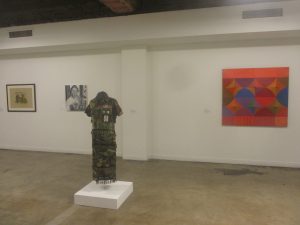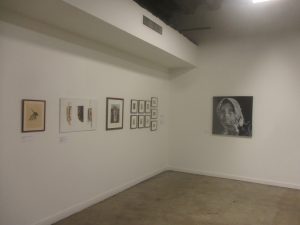‘Original Warrior’ exhibit showcases art by Native-American Veterans
By Igor Studenkov For Chronicle Media — November 19, 2018 When people think of Native Americans serving in the U.S. Military, chances are pretty good that they are thinking about Navajo code talkers. But as the “Original Warrior” exhibit, which opened in early October at Chicago’s National Veterans Art Museum, makes it clear that the history of Native American military service is longer, and far more complex than that.
When people think of Native Americans serving in the U.S. Military, chances are pretty good that they are thinking about Navajo code talkers. But as the “Original Warrior” exhibit, which opened in early October at Chicago’s National Veterans Art Museum, makes it clear that the history of Native American military service is longer, and far more complex than that.
The relationship between the Native Americans and the U.S. military is complex. After all, when Indian tribes tried to hold on to their lands, it was the U.S. Army and state militias that ultimately drove them onto reservations. But, at the same time, there have been Native-American soldiers in the military since the Revolutionary War, and today, Native Americans are more likely to enlist than American citizens as a whole.
The “Original Warriors” exhibit showcases a wide variety of artwork painted and sculpted by Native-American artists who served in World War II, the Vietnam War and other conflicts the United States has been involved in since then. The themes of their work varies as well, delving into the trauma of war, the Native-American cultures and the legacies of American history. The exhibit launched on Oct. 6 and will run until April 22, 2019.
According to the Smithsonian Institute’s National Museum of the American Indian, from World War I onward, Native Americans tended to enlist at higher rates than the overall American population. Its website notes that, since the Sept. 11, 2001 terrorist attacks, 18.6 percent of all Native Americans served in the military, compared to 14 percent of the overall population.

National Veterans Art Museum’s “Original Warrior” exhibit deals with the Native-American perspective on the U.S. military. (Photo by Igor Studenkov/for Chronicle Media
The September 2012 U.S. Department of Veterans Affairs study of the status of American Indian and Native Alaskan service members indicates that this group stands out among service members for several reasons. They are more likely to be younger — 48.9 percent of all Native-American service members were ages 17-24, a number that drops 34.6 percent for service members overall. They are more likely to be women — 19.3 percent versus 15.6 percent for the military overall. They are significantly more likely to serve in the Navy — 47.5 percent of all Native American service members serve there, compared to 13.8 percent of the service members overall. However, they also tend to stay in the military for shorter period of time and are less likely to become officers. Out of all Native American service members, only 6 percent were officers.
At the time of the study, there were 154,305 Native-American veterans — about seven tenths of a percent of the overall veteran population. Illinois was home to 1,577 of them. At the time, Illinois was one of 15 states that had no female Native-American veterans whatsoever.
The study points to several issues Native-American veterans face. Their average income is the lowest among the demographic groups. While they are more likely to have graduated highs school than veterans overall, and they are more likely to attend “some college,” they are less likely to earn a bachelor’s degree and more advanced degrees than veterans as a whole.
Native American veterans were more likely to have disabilities related to their service. And they were also significantly more likely to have no health insurance coverage — 15.3 percent versus 6.3 percent for veterans overall. However, it should be noted that the figures were collected before the Affordable Care Act took effect.
The National Veterans Art Museum started out as a 1981 exhibit of the art by Vietnam War veterans in a gallery in Chicago’s River North neighborhood. The museum moved to the Near South Side, on the corner of 18th Street and Indiana Avenue in 1996. But in the ensuing decade, the neighborhood went through major redevelopment, becoming South Loop. In 2012, it moved to the second floor of Portage Lofts building (at 4041 N. Milwaukee Avenue) in Portage Park neighborhood’s Six Corners shopping district, where it stayed ever since.
Brendan Foster, the museum’s current executive director, told the Chronicle that the Original Warrior exhibit has been in the works for several years, before he even got the job. As NVAM website notes, the museum was looking to explore “the complex Native-American relationships between warrior and community, warrior and war, warrior and service.”
The exhibit is the first thing visitors see when they enter the museum space, and it spans two more rooms beyond that. Foster explained that NVAM Art Committee selected two curators to plan the ins and outs of the exhibit. Photographer Tom Jones, of the Ho-Chunk Nation of Wisconsin, is the assistant professor of photography at the University of Wisconsin-Madison, while sculptor Ash Kyrie is an Iraq War veteran who served as the Art Committee co-chair.
The two curators wound up assembling a wide variety of paintings, sketches, drawings, photographs, three-dimensional installations and pieces that don’t quite fit into any one category. The oldest pieces were created during World War II, while the newest pieces are only a few years old. While most pieces were created by veterans, others were created by non-veterans who were tackling the exhibit’s themes.
Some of the pieces are relatively straight-forward. Clarence Monegar, of the Ho-Chunk nation, who served as an ambulance driver during World War II, painted landscapes. Lloyd Kiva New, of Cherokee nation, painted and sketched warships and other images he saw while serving on the Pacific front during World War II. And Jones contributed a series of photographs recognizing Native-American veterans who served over the past 100 years.
Other pieces dealt more closely with the nature of war. Melissa Doud, a 20-year Army veteran and a member of Lac du Flambeau Band of Lake Superior Chippewa, created one of the most eye-catching pieces in the exhibit, the “Bullet Dress” — a dress made of camouflage fabric with 365 bullet casings sewn in.
“Creating this dress after I came back from Iraq was part of my healing journey,” Doud said in her artist statement. “Now I dance for others and can display the path I went through to get here.”
Post-Traumatic Stress Disorder and other psychological effects of war inform many of the pieces. Iraq War veteran Monty Little, of Dine (Navajo) people, painted the “Contingency Combs Memory” series of paintings, which show images of people with their faces distorted into spirals.
The complex relationship between Native Americans and the military is another recurring theme. Another series of Little’s “Usurp” paintings series depicts figures from American history such as 19th century general William Sherman, who was known for brutal tactics in war against Native-American tribes, with warped, skull-like visages. Photographer Horace Poolaw, of the Kiowa tribe, served in the Army during World War II – and the photos featured in the exhibit chronicled how the cultures of his tribe and other Plains Indians changed over the course of five decades. Artist Teri Greeves, also a Kiowa, created a prayer blanket that placed a modern Native American solider in the context of the warriors that existed centuries earlier.
“This blanket is my prayer — a prayer for the all the Kiowa men and women serving in the Middle East to take their rightful place with the Kiowa warriors that have come before them,” she said in her artist statement.
And some pieces have echoes of both. Vietnam veteran Rick Bartow, of Wyot tribe, created a lithograph of a tormented man with a crow-like shadow. As the exhibit page noted, Bartow describes his work as form of therapy that helped him deal with his PTSD and survivors guilt.

National Veterans Art Museum’s “Original Warrior” exhibit deals with the Native-American perspective on the U.S. military. (Photo by Igor Studenkov/for Chronicle Media)
The exhibit launched in Oct. 6. Foster said that, so far, the response has been positive.
“Although it is difficult to gauge personal takeaway, individuals have been impressed with the unique perspective of Native-American art and the level of respect given to the veterans,” he said.
Foster said that, ultimately, Foster sees the exhibit as the extension of the museum’s mission.
“Fundamentally, NVAM’s mission is to bridge the gap between our broader society and veterans” he said. “Understanding the importance of veteran reintegration and thinking about how society welcomes veterans back into society today is one of the strong takeaways from the exhibition.”








